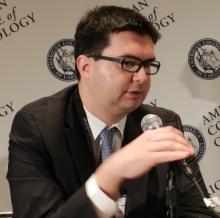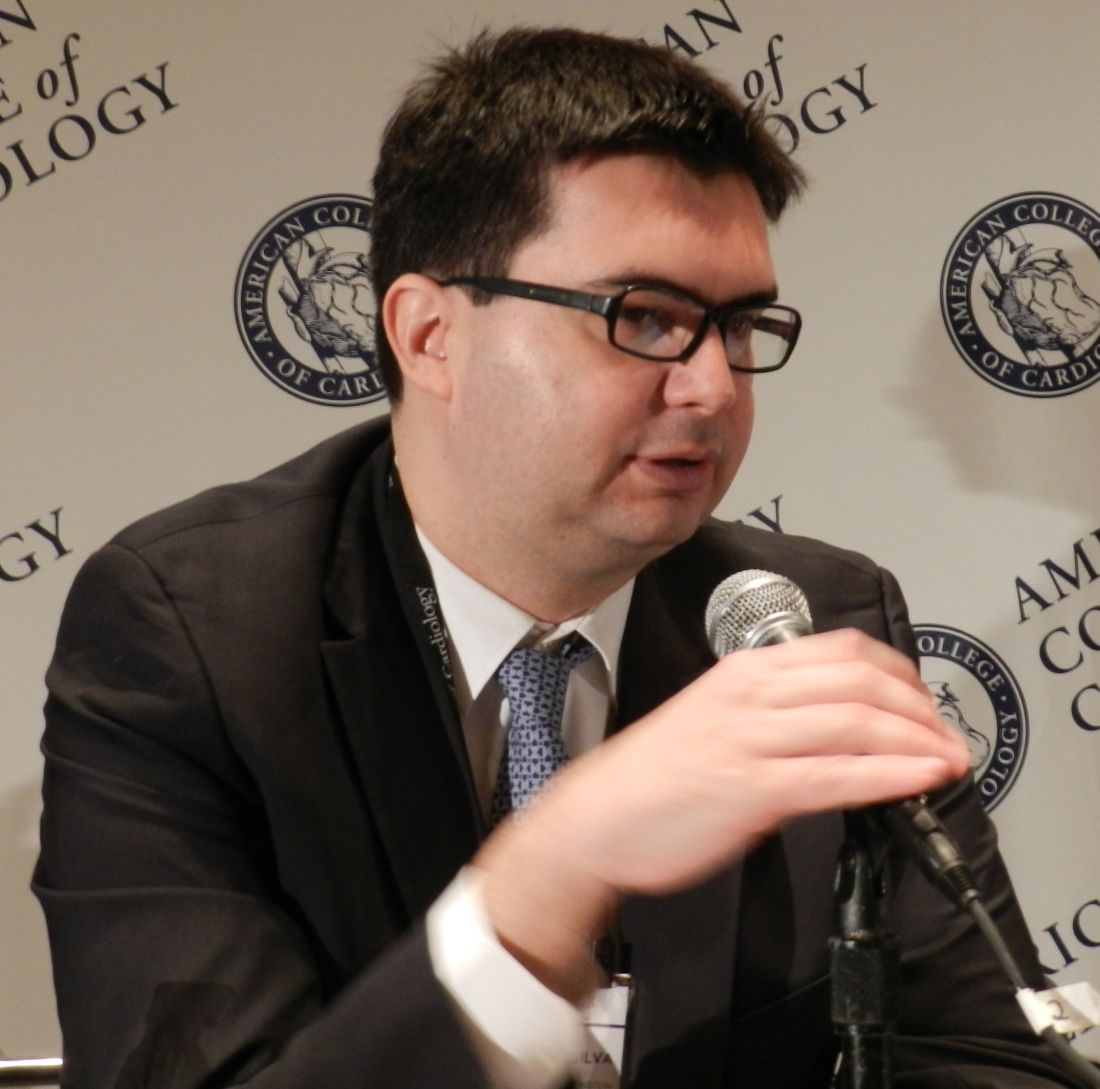User login
For patients under age 75 years with ST-segment elevation myocardial infarction, switching from clopidogrel to ticagrelor was noninferior to continuing clopidogrel in terms of 30-day rates of major bleeding, investigators reported at the annual meeting of the American College of Cardiology.
Rates of thrombolysis in myocardial infarction (TIMI) major bleeding through 30 days were 0.73% in the ticagrelor group and 0.69% in the clopidogrel group, for an absolute difference of 0.04% (95% confidence interval, −0.49% to 0.58%; P less than .001 for noninferiority). “However, minor bleeding was increased with ticagrelor, and there was no benefit on efficacy outcomes,” Otavio Berwanger, MD, PhD, wrote simultaneously in JAMA Cardiology, on behalf of the writing committee for the randomized, phase 3, open-label TREAT trial.
Abundant, robust data support prompt revascularization in ST-elevation myocardial infarction (STEMI), but the real world doesn’t always meet this standard, and lytics remain in wide use in many countries, noted Dr. Berwanger, Director of the Research Institute at the Heart Hospital of Sao Paulo (Brazil). In the early 2000s, two large trials showed that dual antiplatelet therapy with aspirin and clopidogrel reduced major adverse cardiovascular events in patients receiving fibrinolytics for STEMI. More recently, the Platelet Inhibition and Patient Outcomes (PLATO) study favored ticagrelor over clopidogrel for reducing cardiovascular or stroke-related death, with no increase in the risk of major bleeding, despite ticagrelor’s boxed warning.
However, PLATO excluded patients who received fibrinolytics in the 24 hours before treatment because of concerns that ticagrelor might contribute to serious or fatal bleeding. To assess this risk, Dr. Berwanger and his associates from 10 countries randomly assigned 3,799 patients with STEMI to receive either ticagrelor (180-mg loading dose; 90 mg twice daily thereafter) or clopidogrel (300-mg to 600-mg loading dose; 75 mg daily thereafter) a median of 11.4 hours after fibrinolysis. Patients averaged 58 years in age (standard deviation, 9.5 years), 77% were men, and 57% were white.
Because about 90% of patients had been pretreated with clopidogrel, the study primarily compared the effect of staying on clopidogrel with switching to ticagrelor, the investigators noted. “Our trial was an investigator- initiated trial with limited funding that did not allow a double-dummy design,” they added. “We attempted to minimize the risk of bias associated with the open-label nature of the study by performing blinded outcome adjudication.”
In terms of secondary endpoints, 23 patients (1.2%) on ticagrelor developed major bleeding according to PLATO criteria and Bleeding Academic Research Consortium (BARC) criteria, as did 26 patients (1.4%) on clopidogrel at 30-day follow-up (absolute difference, −0.18%; 95% CI, −0.89% to 0.54; P = .001 for noninferiority). Ticagrelor and clopidogrel also resembled each other in terms of fatal bleeds (0.16% versus 0.11%, respectively; P = .67) and intracranial bleeds (0.42% versus 0.37%; P = .82).
However, minimal PLATO bleeding was significantly more common with ticagrelor (3.2%) than with clopidogrel (2%; P = .02), the researchers reported. Clinically significant TIMI bleeding requiring medical attention occurred in 2% of the ticagrelor group and 1.2% of the clopidogrel group (P = .06), and ticagrelor was no more effective than clopidogrel in terms of preventing death from vascular causes, myocardial infarction, or stroke, with a composite rate of 4% in each arm and a statistically insignificant hazard ratio of (0.91; 95% CI, 0.67 to 1.25; P = .57).
Additionally, while similar proportions of patients stopped treatment because of adverse events, dyspnea was more common with ticagrelor (13.9%) than clopidogrel (7.6%). “Based on our findings, patients with STEMI younger than 75 years who initially received clopidogrel can be safely switched to ticagrelor in the first 24 hours after fibrinolysis,” the researchers wrote. “Whether this strategy will result in fewer cardiovascular events in the long term remains to be determined.”
AstraZeneca makes ticagrelor and funded the trial. Dr. Berwanger disclosed grants and personal fees from AstraZeneca and several other pharmaceutical companies.
Source: JAMA Cardiol. doi:10.1001/jamacardio.2018.0612
The TREAT trial “answers some questions, but critical others remain,” Clyde W. Yancy, MD, MSc, and Robert A. Harrington, MD, write in a brief accompanying editorial in JAMA Cardiology.
Perhaps most notably, the trial does not answer the “crucial” question on concomitant ticagrelor-lytic therapy for acute revascularization, they write. “Given the worldwide burden of acute coronary syndromes and the recognized exigencies which preclude the ubiquitous availability of PCI, we believe this question needs urgent attention. We await future trials.”
Dr. Yancy is at Feinberg School of Medicine, Northwestern University, Chicago. Dr. Harrington is at the department of medicine, Stanford University, Stanford, Calif. Dr. Harrington disclosed ties to Astra, Amgen, Bayer, Bristol-Myers Squibb, and several other pharmaceutical companies, and reported having served on the board of directors of the American Heart Association and Stanford Health Care. Dr. Yancy had no disclosures.
The TREAT trial “answers some questions, but critical others remain,” Clyde W. Yancy, MD, MSc, and Robert A. Harrington, MD, write in a brief accompanying editorial in JAMA Cardiology.
Perhaps most notably, the trial does not answer the “crucial” question on concomitant ticagrelor-lytic therapy for acute revascularization, they write. “Given the worldwide burden of acute coronary syndromes and the recognized exigencies which preclude the ubiquitous availability of PCI, we believe this question needs urgent attention. We await future trials.”
Dr. Yancy is at Feinberg School of Medicine, Northwestern University, Chicago. Dr. Harrington is at the department of medicine, Stanford University, Stanford, Calif. Dr. Harrington disclosed ties to Astra, Amgen, Bayer, Bristol-Myers Squibb, and several other pharmaceutical companies, and reported having served on the board of directors of the American Heart Association and Stanford Health Care. Dr. Yancy had no disclosures.
The TREAT trial “answers some questions, but critical others remain,” Clyde W. Yancy, MD, MSc, and Robert A. Harrington, MD, write in a brief accompanying editorial in JAMA Cardiology.
Perhaps most notably, the trial does not answer the “crucial” question on concomitant ticagrelor-lytic therapy for acute revascularization, they write. “Given the worldwide burden of acute coronary syndromes and the recognized exigencies which preclude the ubiquitous availability of PCI, we believe this question needs urgent attention. We await future trials.”
Dr. Yancy is at Feinberg School of Medicine, Northwestern University, Chicago. Dr. Harrington is at the department of medicine, Stanford University, Stanford, Calif. Dr. Harrington disclosed ties to Astra, Amgen, Bayer, Bristol-Myers Squibb, and several other pharmaceutical companies, and reported having served on the board of directors of the American Heart Association and Stanford Health Care. Dr. Yancy had no disclosures.
For patients under age 75 years with ST-segment elevation myocardial infarction, switching from clopidogrel to ticagrelor was noninferior to continuing clopidogrel in terms of 30-day rates of major bleeding, investigators reported at the annual meeting of the American College of Cardiology.
Rates of thrombolysis in myocardial infarction (TIMI) major bleeding through 30 days were 0.73% in the ticagrelor group and 0.69% in the clopidogrel group, for an absolute difference of 0.04% (95% confidence interval, −0.49% to 0.58%; P less than .001 for noninferiority). “However, minor bleeding was increased with ticagrelor, and there was no benefit on efficacy outcomes,” Otavio Berwanger, MD, PhD, wrote simultaneously in JAMA Cardiology, on behalf of the writing committee for the randomized, phase 3, open-label TREAT trial.
Abundant, robust data support prompt revascularization in ST-elevation myocardial infarction (STEMI), but the real world doesn’t always meet this standard, and lytics remain in wide use in many countries, noted Dr. Berwanger, Director of the Research Institute at the Heart Hospital of Sao Paulo (Brazil). In the early 2000s, two large trials showed that dual antiplatelet therapy with aspirin and clopidogrel reduced major adverse cardiovascular events in patients receiving fibrinolytics for STEMI. More recently, the Platelet Inhibition and Patient Outcomes (PLATO) study favored ticagrelor over clopidogrel for reducing cardiovascular or stroke-related death, with no increase in the risk of major bleeding, despite ticagrelor’s boxed warning.
However, PLATO excluded patients who received fibrinolytics in the 24 hours before treatment because of concerns that ticagrelor might contribute to serious or fatal bleeding. To assess this risk, Dr. Berwanger and his associates from 10 countries randomly assigned 3,799 patients with STEMI to receive either ticagrelor (180-mg loading dose; 90 mg twice daily thereafter) or clopidogrel (300-mg to 600-mg loading dose; 75 mg daily thereafter) a median of 11.4 hours after fibrinolysis. Patients averaged 58 years in age (standard deviation, 9.5 years), 77% were men, and 57% were white.
Because about 90% of patients had been pretreated with clopidogrel, the study primarily compared the effect of staying on clopidogrel with switching to ticagrelor, the investigators noted. “Our trial was an investigator- initiated trial with limited funding that did not allow a double-dummy design,” they added. “We attempted to minimize the risk of bias associated with the open-label nature of the study by performing blinded outcome adjudication.”
In terms of secondary endpoints, 23 patients (1.2%) on ticagrelor developed major bleeding according to PLATO criteria and Bleeding Academic Research Consortium (BARC) criteria, as did 26 patients (1.4%) on clopidogrel at 30-day follow-up (absolute difference, −0.18%; 95% CI, −0.89% to 0.54; P = .001 for noninferiority). Ticagrelor and clopidogrel also resembled each other in terms of fatal bleeds (0.16% versus 0.11%, respectively; P = .67) and intracranial bleeds (0.42% versus 0.37%; P = .82).
However, minimal PLATO bleeding was significantly more common with ticagrelor (3.2%) than with clopidogrel (2%; P = .02), the researchers reported. Clinically significant TIMI bleeding requiring medical attention occurred in 2% of the ticagrelor group and 1.2% of the clopidogrel group (P = .06), and ticagrelor was no more effective than clopidogrel in terms of preventing death from vascular causes, myocardial infarction, or stroke, with a composite rate of 4% in each arm and a statistically insignificant hazard ratio of (0.91; 95% CI, 0.67 to 1.25; P = .57).
Additionally, while similar proportions of patients stopped treatment because of adverse events, dyspnea was more common with ticagrelor (13.9%) than clopidogrel (7.6%). “Based on our findings, patients with STEMI younger than 75 years who initially received clopidogrel can be safely switched to ticagrelor in the first 24 hours after fibrinolysis,” the researchers wrote. “Whether this strategy will result in fewer cardiovascular events in the long term remains to be determined.”
AstraZeneca makes ticagrelor and funded the trial. Dr. Berwanger disclosed grants and personal fees from AstraZeneca and several other pharmaceutical companies.
Source: JAMA Cardiol. doi:10.1001/jamacardio.2018.0612
For patients under age 75 years with ST-segment elevation myocardial infarction, switching from clopidogrel to ticagrelor was noninferior to continuing clopidogrel in terms of 30-day rates of major bleeding, investigators reported at the annual meeting of the American College of Cardiology.
Rates of thrombolysis in myocardial infarction (TIMI) major bleeding through 30 days were 0.73% in the ticagrelor group and 0.69% in the clopidogrel group, for an absolute difference of 0.04% (95% confidence interval, −0.49% to 0.58%; P less than .001 for noninferiority). “However, minor bleeding was increased with ticagrelor, and there was no benefit on efficacy outcomes,” Otavio Berwanger, MD, PhD, wrote simultaneously in JAMA Cardiology, on behalf of the writing committee for the randomized, phase 3, open-label TREAT trial.
Abundant, robust data support prompt revascularization in ST-elevation myocardial infarction (STEMI), but the real world doesn’t always meet this standard, and lytics remain in wide use in many countries, noted Dr. Berwanger, Director of the Research Institute at the Heart Hospital of Sao Paulo (Brazil). In the early 2000s, two large trials showed that dual antiplatelet therapy with aspirin and clopidogrel reduced major adverse cardiovascular events in patients receiving fibrinolytics for STEMI. More recently, the Platelet Inhibition and Patient Outcomes (PLATO) study favored ticagrelor over clopidogrel for reducing cardiovascular or stroke-related death, with no increase in the risk of major bleeding, despite ticagrelor’s boxed warning.
However, PLATO excluded patients who received fibrinolytics in the 24 hours before treatment because of concerns that ticagrelor might contribute to serious or fatal bleeding. To assess this risk, Dr. Berwanger and his associates from 10 countries randomly assigned 3,799 patients with STEMI to receive either ticagrelor (180-mg loading dose; 90 mg twice daily thereafter) or clopidogrel (300-mg to 600-mg loading dose; 75 mg daily thereafter) a median of 11.4 hours after fibrinolysis. Patients averaged 58 years in age (standard deviation, 9.5 years), 77% were men, and 57% were white.
Because about 90% of patients had been pretreated with clopidogrel, the study primarily compared the effect of staying on clopidogrel with switching to ticagrelor, the investigators noted. “Our trial was an investigator- initiated trial with limited funding that did not allow a double-dummy design,” they added. “We attempted to minimize the risk of bias associated with the open-label nature of the study by performing blinded outcome adjudication.”
In terms of secondary endpoints, 23 patients (1.2%) on ticagrelor developed major bleeding according to PLATO criteria and Bleeding Academic Research Consortium (BARC) criteria, as did 26 patients (1.4%) on clopidogrel at 30-day follow-up (absolute difference, −0.18%; 95% CI, −0.89% to 0.54; P = .001 for noninferiority). Ticagrelor and clopidogrel also resembled each other in terms of fatal bleeds (0.16% versus 0.11%, respectively; P = .67) and intracranial bleeds (0.42% versus 0.37%; P = .82).
However, minimal PLATO bleeding was significantly more common with ticagrelor (3.2%) than with clopidogrel (2%; P = .02), the researchers reported. Clinically significant TIMI bleeding requiring medical attention occurred in 2% of the ticagrelor group and 1.2% of the clopidogrel group (P = .06), and ticagrelor was no more effective than clopidogrel in terms of preventing death from vascular causes, myocardial infarction, or stroke, with a composite rate of 4% in each arm and a statistically insignificant hazard ratio of (0.91; 95% CI, 0.67 to 1.25; P = .57).
Additionally, while similar proportions of patients stopped treatment because of adverse events, dyspnea was more common with ticagrelor (13.9%) than clopidogrel (7.6%). “Based on our findings, patients with STEMI younger than 75 years who initially received clopidogrel can be safely switched to ticagrelor in the first 24 hours after fibrinolysis,” the researchers wrote. “Whether this strategy will result in fewer cardiovascular events in the long term remains to be determined.”
AstraZeneca makes ticagrelor and funded the trial. Dr. Berwanger disclosed grants and personal fees from AstraZeneca and several other pharmaceutical companies.
Source: JAMA Cardiol. doi:10.1001/jamacardio.2018.0612
FROM ACC 2018
Key clinical point: Ticagrelor was noninferior to clopidogrel after fibrinolytic therapy in patients with ST-elevation myocardial infarction.
Major finding: Rates of thrombolysis in myocardial infarction (TIMI) major bleeding through 30 days were 0.73% and 0.69%, respectively (absolute difference, 0.04%; 95% confidence interval, −0.49% to 0.58%; P less than .001 for noninferiority).
Data source: A phase 3, international, randomized, open-label trial with blinded outcomes assessments of 3,799 patients with ST-elevation myocardial infarction (TREAT).
Disclosures: AstraZeneca makes ticagrelor and funded the trial. Dr. Berwanger disclosed grants and personal fees from AstraZeneca and several other pharmaceutical companies.
Source: JAMA Cardiol. doi:10.1001/jamacardio.2018.0612


